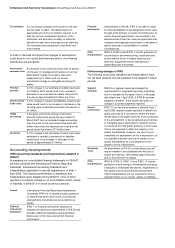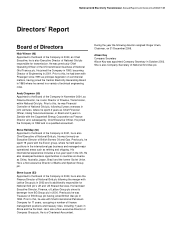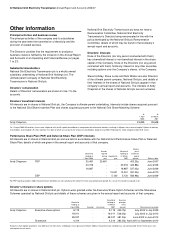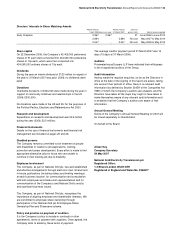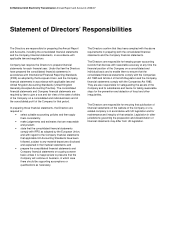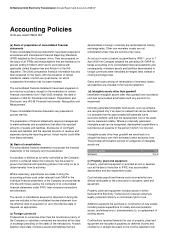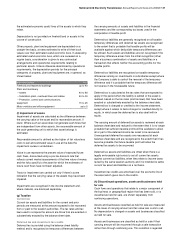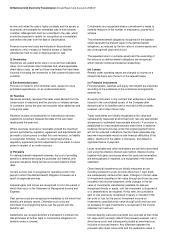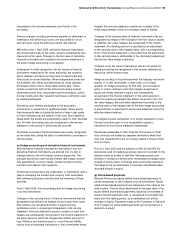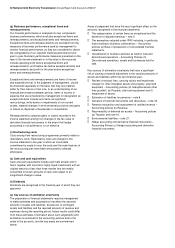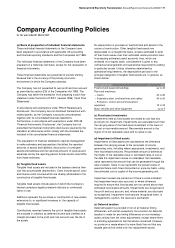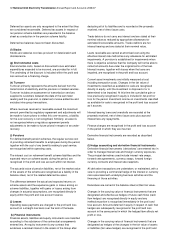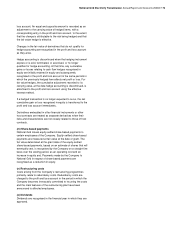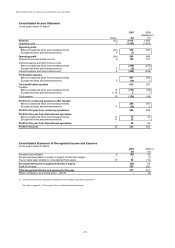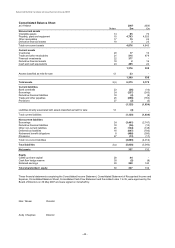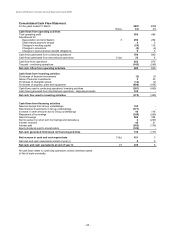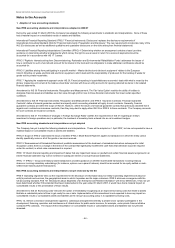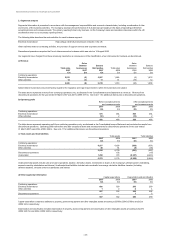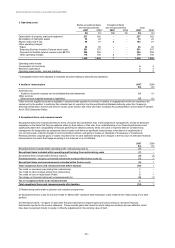National Grid 2007 Annual Report Download - page 41
Download and view the complete annual report
Please find page 41 of the 2007 National Grid annual report below. You can navigate through the pages in the report by either clicking on the pages listed below, or by using the keyword search tool below to find specific information within the annual report. National Grid Electricity Transmission Annual Report and Accounts 2006/07 39
recognised in the income statement over the life of the
borrowing.
Finance charges, including premiums payable on settlement or
redemption and direct issue costs, are accounted for on an
accruals basis using the effective interest rate method.
With effect from 1 April 2005, derivative financial instruments
are recognised initially at fair value, and are subsequently also
measured at fair value. Changes in the fair value of derivative
financial instruments are included in the income statement to
the extent hedge accounting is not applied.
Subsequent to initial recognition, the fair values of financial
instruments measured at fair value and which are quoted in
active markets, are based on bid prices for assets held and
offer prices for issued liabilities. When independent prices are
not available, fair values are determined by using valuation
techniques which refer to observable market data. These
include comparison with similar instruments where market
observable prices exist, discounted cash flow analysis, option
pricing models and other valuation techniques commonly used
by market participants.
Borrowing costs directly attributable to the acquisition,
construction or production of qualifying assets (being assets
that necessarily take a substantial period of time to get ready
for their intended use) are added to their cost. Such additions
cease when the assets are substantially ready for their intended
use. All other borrowing costs are recognised in the income
statement in the period in which they are incurred.
Purchases and sales of financial assets are usually recognised
on the trade date, being the date of commitment to purchase or
sell the assets.
(o) Hedge accounting and derivative financial instruments
Both derivative financial instruments (‘derivatives’) and non-
derivative financial instruments are entered into in order to
manage interest rate and foreign currency exposures. The
principal derivatives used include interest rate swaps, forward
rate agreements, currency swaps, forward foreign currency
contracts and interest rate swaptions.
All derivative transactions are undertaken, or maintained, with a
view to managing the interest and currency risks associated
with underlying business activities and the financing of those
activities.
From 1 April 2005, the accounting policy for hedge accounting
is as described below.
Changes in the carrying value of financial instruments that are
designated and effective as hedges of future cash flows (cash
flow hedges) are recognised directly in equity and any
ineffective portion is recognised immediately in the income
statement. Amounts deferred in equity in respect of cash flow
hedges are subsequently recognised in the income statement in
the same period in which the hedged item affects net profit or
loss. Where a non-financial asset or a non-financial liability
results from a forecasted transaction or firm commitment being
hedged, the amounts deferred in equity are included in the
initial measurement of that non-monetary asset or liability.
Changes in the carrying value of financial instruments that are
designated as hedges of the changes in the fair value of assets
or liabilities (fair value hedges) are recognised in the income
statement. An offsetting amount is recorded as an adjustment
to the carrying value of the hedged items, with a corresponding
entry in the income statement, to the extent that the adjustment
to the carrying value is attributable to the risk being hedged and
that the fair value hedge is effective.
Changes in the fair value of derivatives that do not qualify for
hedge accounting are recognised in the income statement as
they arise, within finance costs.
Hedge accounting is discontinued when the hedging instrument
expires or is sold, terminated, or exercised, or no longer
qualifies for hedge accounting. At that time, any cumulative
gains or losses relating to cash flow hedges recognised in
equity are initially retained in equity and subsequently
recognised in the income statement, in the same periods in
which the previously hedged item affects net profit or loss. For
fair value hedges, the cumulative adjustment recorded to the
carrying value of the hedged item at the date hedge accounting
is discontinued, is amortised to the income statement using the
effective interest method.
If a hedged forecast transaction is no longer expected to occur,
the net cumulative gain or loss recognised in equity is
transferred to the income statement immediately.
Derivatives embedded in other financial instruments or other
host contracts are treated as separate derivatives when their
risks and characteristics are not closely related to those of their
host contracts.
Prior to 1 April 2005 and the adoption of IAS 32 and IAS 39,
derivatives used for hedging purposes were not recorded on the
balance sheet as assets or liabilities. Monetary assets and
liabilities in foreign currencies were retranslated at hedged rates
instead of closing rates. Exchange gains and losses relating to
the hedge of the net investment in overseas subsidiaries were
recorded directly in equity.
(p) Share-based payments
National Grid issues equity-settled share-based payments to
certain employees of the Company and its subsidiaries. Equity-
settled share-based payments are measured at fair value at the
date of grant. The fair value determined at the grant date of the
equity-settled share-based payments, based on an estimate of
shares that will eventually vest, is recognised on a straight-line
basis over the vesting period, as an operating cost and an
increase in equity. Payments made by the Company to National
Grid in respect of share-based payments are recognised as a
reduction in equity.



